In recent years, the humble pantry has undergone a remarkable transformation, evolving from a simple storage closet into a statement piece that enhances both the functionality and aesthetics of our homes.
With the rise of home cooking durng the pandemic and beyond, pantries have become essential spaces that deserve thoughtful design attention.
Whether you’re working with a spacious walk-in or a couple of dedicated cabinets, proper pantry organization isnt just about looking pretty on Instagram—it’s about creating systems that make daily life smoother and more efficient.
According to a 2023 survey by the National Association of Home Builders, pantry spaces now rank among the top five most-requested features in new home construction,
with 83% of buyers considering them “essential” or “desirable.” This shift reflects our changing relationship with food storage and meal preparation.
In this comprehensive guide, we’ll explore practical solutions for pantries of all sizes, innovative organization techniques, and design elements that blend form and function.
From space-maximizing strategies to aesthetic considerations, this article aims to provide you with actionable ideas to transform your pantry into an organized, efficient, and stylish space that works for your unique household needs.
Understanding Your Pantry Needs
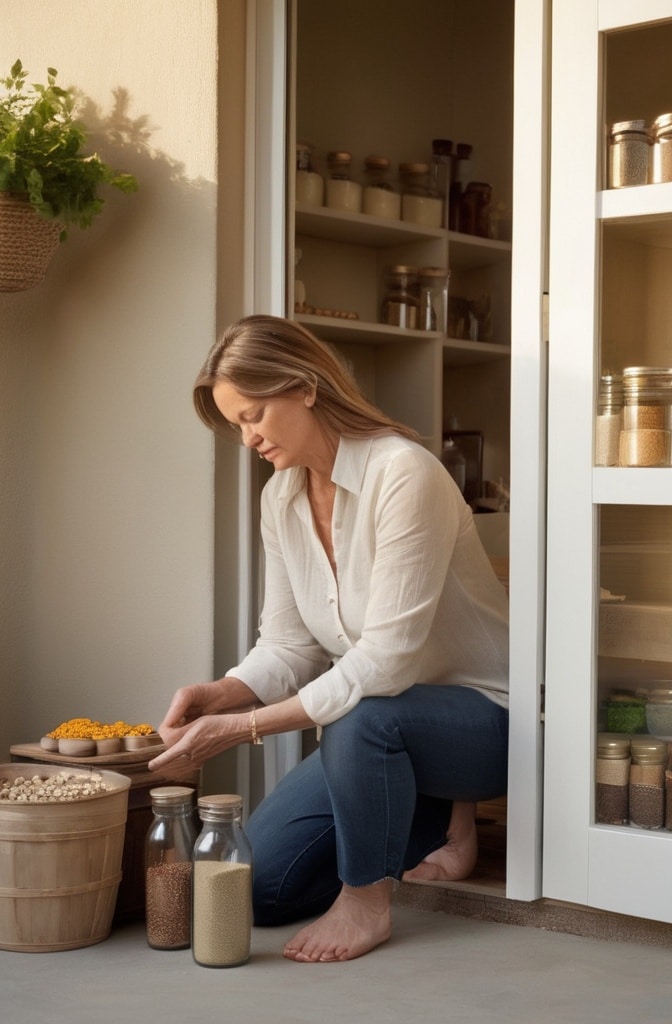
Before diving into organization solutions or aesthetic improvements, take time to assess your household’s unique storage requirements. Every family has different cooking habits, shopping patterns, and space constraints that should inform your pantry design decisions.
Assessing Your Household’s Unique Requirements
Start by asking yourself some key questions about how you use your kitchen:
- How often do you grocery shop? (Bulk buyers need different systems than frequent shoppers)
- What types of foods do you stock most? (Canned goods, baking supplies, snacks, etc.)
- Who needs to access the pantry? (Adults only, children, elderly family members)
- What frustrates you most about your current setup?
Home organization expert Marie Kondo suggests that “tidying is the act of confronting yourself,” and your pantry is no exception. By honestly evaluting your needs, you’ll avoid implementing systems that look great but don’t actually work for your lifestyle.
Identifying Pain Points in Your Current Setup
Take inventory of your existing pantry challenges. Common pain points include:
- Items getting lost or forgotten in the back of deep shelves
- Difficulty seeing what’s available at a glance
- Family members unable to find things (or put them back properly)
- Wasted space due to inefficient shelving
- Food expiring before it gets used
Professional organizer Shira Gill notes, “The first step to creating lasting change is to clearly identify what’s not working. Before buying a single container, get crystal clear on the specific problems you’re trying to solve.”
Taking Inventory of What Actually Needs Storing
A surprising number of pantries are filled with items that don’t technically need to be there. Before reorganizing, empty everything out and sort items into categories. This process often reveals duplicate items, expired products, and belongings that might be better stored elsewhere.
Consider which items genuinely belong in your pantry versus those that might work better in:
- Kitchen cabinets (for frequently used items)
- Basement/garage storage (for bulk or seasonal items)
- Refrigerator (for items that actually need cooling)
- Donation pile (for food you realistically won’t use)
The Psychology Behind Visible vs. Hidden Storage
Interestingly, our pantry organization affects more than just efficiency—it impacts our mental state and food choices. Research in environmental psychology suggests that visible storage can contribute to decision fatigue, the phenomenon where our ability to make good choices deteriorates after making many decisions.
“Every time you open a cluttered pantry, you’re forcing your brain to make dozens of micro-decisions about what to see, ignore, or consider,” explains behavioral scientist Dr. Susan Weinschenk. “This cognitive load taxes your mental resources before you’ve even started cooking.”
This doesn’t necessarily mean hiding everything away—rather, it argues for intentional visibility. Items you want to use frequently (like nutritious ingredients) might benefit from prominent placement, while treats or specialty ingredients might work better in designated, less-visible zones.
Pantry Types: Finding Your Perfect Match
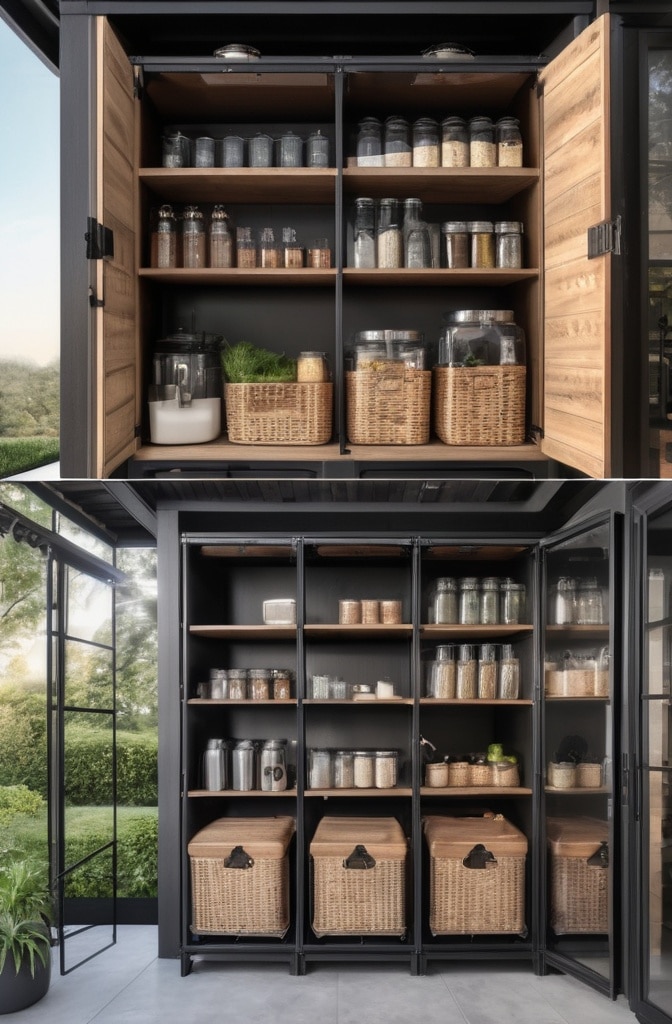
The physical configuration of your pantry fundamentally shapes your organization possibilities. Let’s explore different pantry types and how to maximize each one.
Walk-In Pantries: Maximizing Floor-to-Ceiling Potential
The walk-in pantry represents the gold standard for many homeowners, offering generous storage in a dedicated room. To maximize this luxurious space:
- Install adjustable shelving systems that can adapt as your needs change
- Consider U-shaped configurations that utilize three walls
- Incorporate counter space for small appliances or food prep
- Designate zones based on food types or meal categories
- Use the door for additional storage with hanging organizers
Designer Sarah Richardson recommends, “Even in spacious pantries, think vertically. Most walk-ins have untapped potential near the ceiling for seasonal or rarely-used items.”
Butler’s Pantries: The Multi-Functional Approach
Historically used by household staff for food preparation and storage, today’s butler’s pantries serve as transitional spaces between kitchens and dining areas. These multi-functional spaces excel when designed with dual purposes in mind:
- Storage for formal dinnerware and serving pieces
- Secondary prep space during entertaining
- Beverage stations or coffee bars
- Overflow refrigeration or specialized appliances
“Butler’s pantries work best when they alleviate pressure from the main kitchen,” notes interior designer Lauren Liess. “They should complement rather than duplicate your primary kitchen storage.”
Hidden Pantries: Creative Solutions Behind Cabinet Doors
For homes without dedicated pantry rooms, hidden pantries offer smart solutions. These might take the form of:
- Pull-out cabinet pantries that maximize depth
- Converted closets repurposed for food storage
- Under-stair spaces transformed with custom shelving
- Tall cabinets with organized interiors
HGTV designer Joanna Gaines frequently incorporates hidden pantries in her renovations, noting that “sometimes the best storage solutions are the ones that seamlessly blend into your existing cabinetry.” These spaces work best with highly organized internal systems since space is at a premium.
Small Space Solutions: Transforming Nooks and Crannies
Even the smallest kitchens can incorporate pantry functionality with creative thinking:
- Narrow roll-out cabinets between appliances
- Over-refrigerator cabinets with step stools for access
- Wall-mounted shelf systems in unused corners
- Recessed shelving between wall studs
According to apartment therapy expert Maxwell Ryan, “The key to small pantry spaces isn’t finding more room—it’s maximizing every cubic inch of the space you already have through thoughtful organization systems.”
Open Shelving vs. Closed Cabinet Debate
The decision between open shelving and closed cabinets involves tradeoffs worth considering:
Open Shelving Pros:
- Visual accessibility to all items
- Encourages tidiness and aesthetic organization
- Creates an airy, spacious feeling
- Can showcase beautiful containers or collections
Open Shelving Cons:
- Exposes items to dust
- Requires consistent maintenance
- Can look cluttered if not meticulously organized
- May create visual overwhelm
Closed Cabinet Pros:
- Conceals visual clutter
- Protects items from dust and light
- Provides a clean, minimalist aesthetic
- Allows for “real-life” organization without visual perfection
Closed Cabinet Cons:
- Items can get lost in the back
- Reduced visibility may lead to forgotten inventory
- May waste space with inefficient internal organization
Designer Emily Henderson suggests a hybrid approach: “Consider using closed storage for bulk items and open shelving for everyday essentials and visually appealing staples. This gives you the best of both worlds.”
Essential Organization Systems That Actually Work
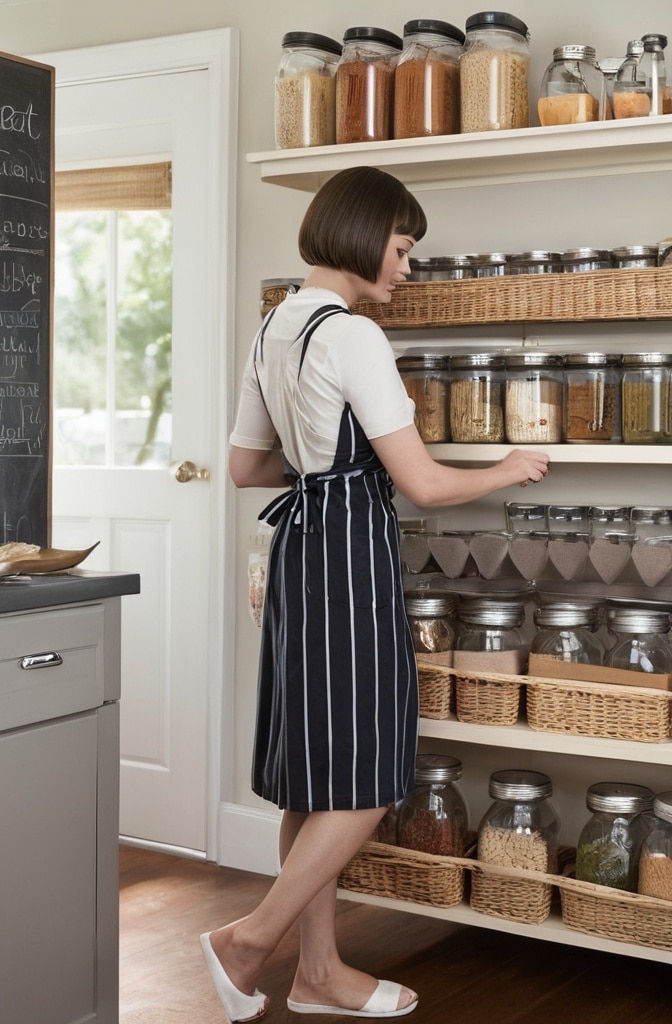
Beyond the physical structure, effective pantry organization relies on systems that match your lifestyle and remain sustainable long-term.
Zone-Based Organization: Creating Intuitive Food Categories
Professional organizers consistently recommend zone-based systems, where similar items are grouped together based on logical categories. Effective pantry zones might include:
- Breakfast items
- Baking supplies
- Canned goods
- Pasta and grains
- Snacks
- Cooking oils and vinegars
- Spices and seasonings
“The key is creating zones that make sense for how you cook and eat,” explains professional organizer Clea Shearer of The Home Edit. “Your categories should reflect your habits, not someone else’s Instagram pantry.”
For maximum effectiveness, consider storing items where they’ll be used. For instance, if you bake infrequently, those supplies might go on higher or lower shelves, while everyday snacks should be easily accessible.
Vertical Storage Strategies for Ceiling-to-Floor Efficiency
Vertical space remains among the most underutilized assets in most pantries. To maximize height:
- Install adjustable shelving that can accommodate items of varying heights
- Use stackable containers that lock together securely
- Incorporate hanging storage under shelves for lightweight items
- Install hooks or pegboards on walls for tools or small items
- Consider shelf risers to create additional levels within existing shelves
“Most pantries have at least 30% more capacity than people realize, simply by using vertical space more effectively,” notes storage expert Marissa Hagmeyer.
The Decanting Debate: When It’s Worth Transferring to Containers
Transferring pantry staples from original packaging into uniform containers has become increasingly popular, but is it always necessary? Consider these factors:
Benefits of Decanting:
- Creates uniform appearance
- Makes it easier to see quantity remaining
- Can protect against pests
- Often maximizes shelf space with stackable containers
- Allows for clearer labeling
When to Skip Decanting:
- For items used very quickly (won’t sit long enough to benefit)
- Products with short shelf lives
- Foods with specific storage instructions on original packaging
- When budget or time constraints make it impractical
Food safety expert J. Kenji López-Alt recommends a practical approach: “Decant dry goods that you buy in bulk and use regularly, like flour, sugar, pasta, and cereal. These benefit most from proper storage and visibility.”
Rotation Systems to Minimize Food Waste
Americans waste approximately 30-40% of their food supply, according to the USDA, and poor pantry organization contributes significantly to this problem. Implement rotation systems that ensure older products get used before newer ones:
- Use “first in, first out” (FIFO) systems where new items go behind older ones
- Label containers with purchase or expiration dates
- Place items with approaching expiration dates in a designated “use soon” section
- Schedule regular pantry “shop-throughs” before grocery trips
- Maintain an inventory list for items stored in less visible areas
Sustainability expert Anne-Marie Bonneau suggests, “The most organized pantry isn’t just arranged beautifully—it’s designed to ensure you actually use what you have before it expires.”
Special Considerations for Bulk Buyers
Warehouse club members and bulk shoppers face unique pantry challenges. If you frequently purchase large quantities:
- Designate separate “active” and “backup” storage areas
- Consider off-site storage for true overflow (like basement shelving)
- Invest in food-safe bulk containers for large quantities
- Create systems for transferring portions to kitchen-accessible containers
- Maintain inventory lists to prevent duplicate purchases
“Bulk buying only saves money when you can properly store and actually use what you purchase,” points out consumer finance expert Tiffany Aliche. “Your organization system needs to account for both storage and practical accessibility.”
Storage Solutions That Transform Functionality
The right storage tools can dramatically improve pantry functionality, transforming frustrating spaces into efficient ones.
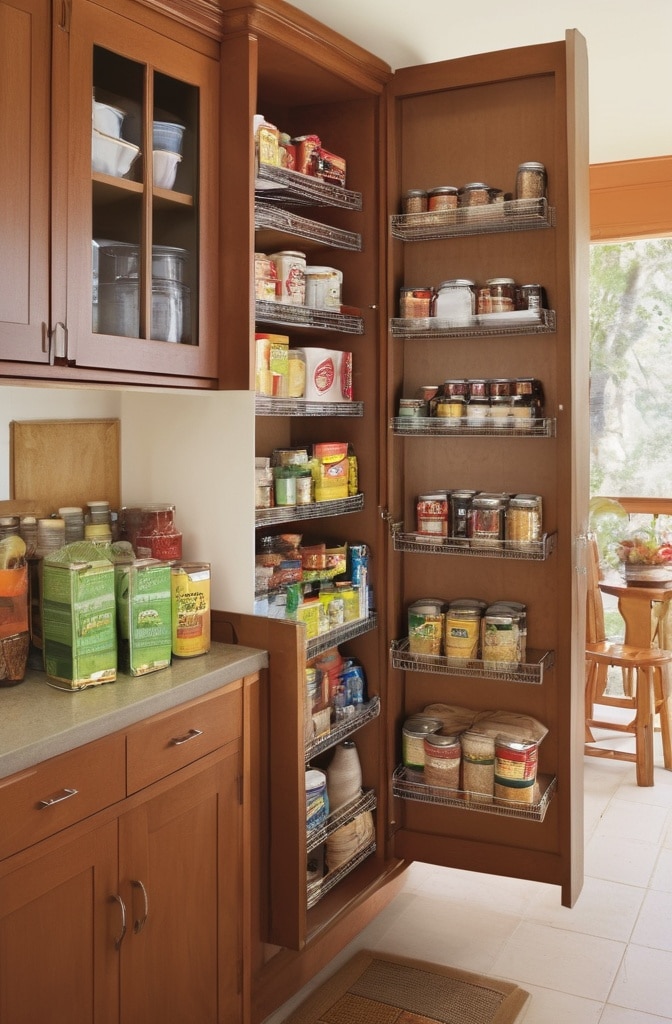
Clear Containers: Beyond Aesthetics to Practical Visibility
Clear storage containers offer more than just Instagram appeal—they serve practical purposes by:
- Allowing instant visual inventory assessment
- Preventing pest infestations
- Keeping food fresher longer with airtight seals
- Maximizing vertical space through stackability
- Creating uniform shapes that fit efficiently on shelves
When choosing clear containers, consider:
- Material (glass vs. plastic)
- Seal quality
- Size versatility
- Dishwasher safety for cleaning
- Durability
Professional organizer Nikki Boyd recommends, “Invest in high-quality containers for items you use most frequently. Budget-friendly options work fine for occasional-use items, but daily-access storage deserves durability.”
Pull-Out Shelves: Accessing the Unreachable Depths
Deep pantry shelves often create “black holes” where items get lost and forgotten. Pull-out solutions transform these problematic spaces:
- Custom drawer systems that extend fully
- Retrofit sliding shelves for existing cabinets
- Wire baskets on glides for lightweight items
- Heavy-duty drawer systems for appliances or bulk items
These systems typically increase usable storage by 30-50% by making the entire depth accessible rather than just the front portion. While professional installation offers perfect fit, many DIY options are now available for various cabinet sizes and weight requirements.
Lazy Susans: Reinventing Corner Spaces
Corner spaces represent some of the most challenging pantry real estate. Rotating organizers (Lazy Susans) effectively solve this problem by:
- Making all items accessible with a simple spin
- Eliminating the need to reach into deep corners
- Providing natural organization through divided sections
- Working well for small items like spices or condiments
Available in various sizes and materials, these rotating organizers work well in both corner cabinets and on shelves. Two-tier versions maximize vertical space within tall cabinets.
Door Racks: The Overlooked Storage Opportunity
Pantry doors offer valuable but often ignored storage potential. Options include:
- Over-the-door organizers with adjustable pockets
- Mounted spice racks or narrow shelving
- Hook systems for lightweight tools
- Magnetic strips for metal containers
- Chalkboard or whiteboard panels for notes and inventory lists
When selecting door storage, be mindful of door clearance and swing radius. Slim profile options work best for tight spaces where doors need to close completely.
Stackable Bins: Maximizing Every Cubic Inch
Stackable storage solutions multiply available space by utilizing the full height between shelves:
- Interlocking bins for secure stacking
- Clear-front options for visibility
- Handled versions for easy retrieval
- Specialized designs for specific items (can organizers, bottle storage)
“The space between standard shelves often has 3-4 inches of wasted vertical space,” observes organization expert Andrew Mellen. “Stackable bins reclaim this otherwise useless area.”
Baskets: Flexible Organization that Adapts with Your Needs
Baskets provide containment with flexibility, making them ideal for:
- Grouping similar loose items together
- Corralling snack packages and pouches
- Creating portable kits (baking supplies, dinner ingredients)
- Accommodating irregularly shaped items
- Adding visual warmth to the space
Choose baskets with these practical considerations in mind:
- Cleanability (food spills happen)
- Visibility (can you see contents without removing the basket?)
- Handle design (for easy removal from shelves)
- Durability for intended weight
Designer Nate Berkus suggests, “Baskets should be beautiful enough that you enjoy using them, but practical enough that they actually solve a storage problem. That balance is key.”
Visibility Enhancements: Finding What You Need
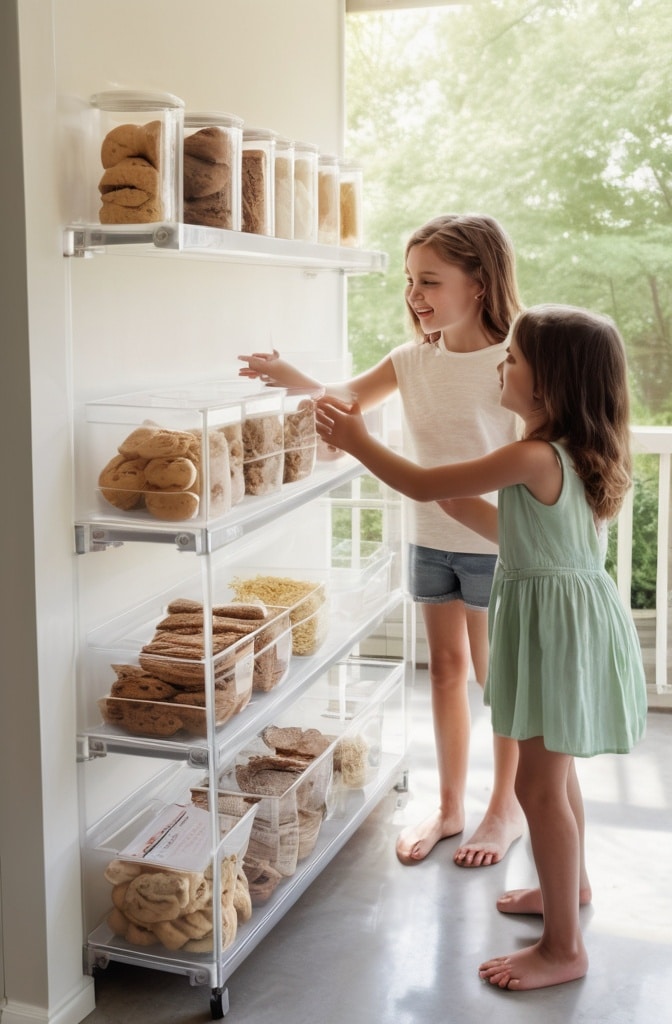
Even the most organized pantry fails if you can’t easily find and access what you need. These visibility solutions help ensure your system remains functional long-term.
Strategic Lighting Options for Dark Corners
Proper illumination dramatically improves pantry functionality. Consider these lighting options:
- Under-shelf LED strip lighting
- Wireless puck lights for dark corners
- Motion-activated lights for walk-in pantries
- Battery-operated options for rentals or unwired areas
- Smart lighting systems that connect to home automation
According to lighting designer Randall Whitehead, “The right pantry lighting doesn’t just help you find ingredients—it makes the space more inviting, which encourages maintaining organization.”
For shelving units without built-in lighting, inexpensive battery-operated options have improved dramatically in recent years, with slim profiles that don’t intrude on storage space.
Label Systems that Actually Maintain Themselves
Effective labeling is the key to sustaining any organization system, but only if it’s practical to maintain:
- Erasable or adjustable labels for containers with changing contents
- Category labels for baskets holding various items
- Color-coding systems for different food types or family members
- Digital labeling systems that connect to inventory apps
- Label placement that’s visible even when items are partially obscured
“The best labeling system is one you’ll actually maintain,” advises professional organizer Shira Gill. “Perfection isn’t sustainable—practicality is.”
Consider who needs to understand your labeling system. If children or other household members need to find and return items, ensure labels are clear and intuitive for all users.
Chalkboard Surfaces for Inventory Tracking
Chalkboard or whiteboard elements add functional communication to pantry spaces:
- Door-mounted boards for shopping lists
- Small tags on containers for expiration dates
- Inventory counts for bulk items
- Meal planning surfaces
- Recipe notes or cooking instructions
These writable surfaces help bridge the gap between physical organization and household communication. They’re particularly valuable for households where multiple people shop or cook.
Technology Integration: Apps and Systems for Pantry Management
For tech-savvy households, digital tools can enhance pantry organization:
- Inventory apps that track expiration dates
- QR code systems for detailed product information
- Voice-activated assistants for adding items to shopping lists
- Smart containers that monitor contents
- Meal planning software that connects to pantry inventory
While not essential, these technological aids can help maintain systems once established. The Pantry Check app, for example, allows users to scan barcodes when adding or removing items, maintaining a real-time inventory and generating shopping lists automatically.
Color-Coding Techniques for Visual Organization
Color provides instant visual cues that help maintain organization:
- Colored containers for different food categories
- Colored labels for identifying contents quickly
- Rim colors on clear containers for easy categorization
- Colored dots or stickers for noting purchase dates
- Portion-specific colors for dietary management
This approach works particularly well for households with children, visual thinkers, or multiple users accessing the pantry regularly. The key is consistency in your color assignments.
Specialized Pantry Zones
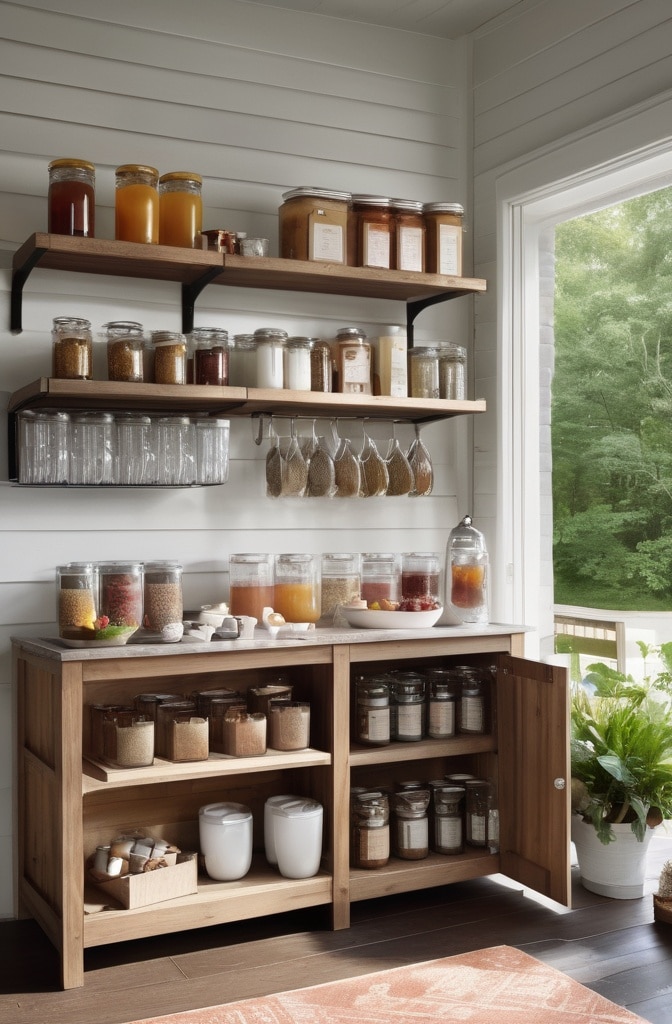
Beyond general organization, dedicated zones for specific activities can transform how you use your kitchen on a daily basis.
The Baking Station: Ingredients, Tools, and Workflow
Frequent bakers benefit from consolidating supplies in one accessible area:
- Flours and sugars in stackable containers
- Measuring tools hung nearby or in dedicated containers
- Specialized ingredients grouped together
- Mixing bowls and equipment within reach
- Recipe storage or display options
“A well-designed baking zone should allow you to begin a recipe without hunting through multiple cabinets,” explains pastry chef Stella Parks. “The efficiency transforms baking from a major production into an accessible daily activity.”
Consider vertical measurement markings on containers and conversion charts mounted inside cabinet doors for added functionality.
Breakfast Bar: Morning Efficiency Solutions
Mornings are often the most hectic time in many households. A dedicated breakfast zone streamlines this daily routine:
- Cereals in easy-pour containers
- Coffee supplies organized by workflow
- Breakfast-specific dishes nearby
- Grab-and-go options prominently displayed
- Toaster or small appliance space if appropriate
This zone works best positioned near the refrigerator for milk and perishable breakfast items. For families with children, consider lower placement of appropriate items to encourage independence.
Coffee Station: Creating the Perfect Brew Setup
For coffee enthusiasts, a dedicated station elevates the brewing experience while keeping supplies organized:
- Beans in airtight containers protected from light
- Mugs within easy reach
- Filters, tools, and accessories in designated containers
- Sweeteners and additions in appropriate storage
- Space for equipment (grinder, scale, etc.)
“Coffee stations work best when organized by workflow,” advises barista James Hoffmann. “Arrange items in the sequence you’ll use them during preparation.”
For small spaces, consider a dedicated shelf or cabinet section rather than counter space. The organization principles remain the same, just in a more compact arrangement.
Kid-Friendly Zones: Promoting Independence and Healthy Choices
Thoughtfully designed children’s pantry zones encourage self-sufficiency and better food choices:
- Lower shelves or baskets for appropriate snacks
- Clear containers for easy identification
- Pre-portioned options in grab-and-go containers
- Visual guides for younger children (pictures of contents)
- Limited options to prevent overwhelming choices
Nutritionist Jennifer Anderson suggests, “The items you make most accessible to children are the ones they’ll choose most often. Use this principle to naturally guide them toward healthier options.”
These zones should evolve as children grow, with different heights, content selections, and independence levels appropriate to their development.
Entertaining Supplies: Keeping Party Essentials Organized
For frequent hosts, dedicated entertainment storage prevents last-minute scrambling:
- Serving pieces organized by type or occasion
- Bar supplies grouped together
- Special occasion ingredients with long shelf life
- Cocktail napkins and disposable serving items
- Party platters and specialized serveware
“Having entertaining essentials organized and accessible makes impromptu gatherings much more feasible,” notes entertaining expert Ina Garten. This zone may include non-food items that support entertaining functionality.
Aesthetic Considerations

A beautiful pantry isn’t just pleasant to look at—it often inspires better maintenance and organization habits.
Wallpaper and Paint: Making Storage Beautiful
Strategic use of color and pattern can transform utilitarian storage into a design feature:
- Bold wallpaper on the back wall of open shelving
- Painted shelf edges in accent colors
- Patterned shelf liners that protect while decorating
- Contrasting paint inside cabinet doors
- Colorful backing behind glass-front cabinets
“The pantry has become a space where people want to express personality,” observes interior designer Emily Henderson. “These small touches make a functional space feel intentional and designed.”
For rental properties or those hesitant to commit, removable wallpaper and temporary shelf liners offer similar benefits without permanent changes.
Hardware Choices that Elevate the Everyday
Knobs, pulls, and handles are the jewelry of your pantry, adding both function and style:
- Statement pulls that complement kitchen design
- Specialized hardware for specific functions (pull-outs, heavy doors)
- Consistent finishes that unify the space
- Ergonomic designs that improve accessibility
- Contrasting metals for visual interest
When selecting hardware, balance aesthetic appeal with practical function. The most beautiful pull still needs to comfortably open your cabinet on a daily basis.
Cohesive Container Strategies
While matching containers create visual calm, they represent a significant investment. Consider these approaches to container cohesion:
- Matching containers for visible areas, budget options elsewhere
- Consistent material (all glass or all plastic) but various shapes
- Unified color palette but different manufacturers
- Matching categories (all baking containers from one set, etc.)
- Gradual replacement as budget allows
“Perfect coordination isn’t necessary for function,” reassures designer Joanna Gaines. “Find a balance between visual harmony and practical reality that works for your budget and lifestyle.”
Display-Worthy Organization (When Function Meets Form)
Some pantry items deserve to be showcased rather than hidden:
- Colorful dried pasta in clear jars
- Artisanal oils and vinegars on exposed shelving
- Vintage canisters or containers with character
- Color-coordinated canned goods in open storage
- Attractively packaged specialty items
This approach works particularly well for items with visual appeal that you use regularly enough to maintain the display. Designer Sarah Richardson suggests, “Think of open pantry shelving as functional decor—the items should earn their visible placement through both beauty and utility.”
Budget-Friendly Styling Options
Beautiful pantry organization doesn’t require expensive container systems or custom cabinetry:
- Repurposed glass jars with uniform painted lids
- Basket liners cut from coordinating fabric
- Chalk paint to transform mismatched containers
- DIY labels using printable templates
- Thrifted containers unified with consistent labeling
“Some of the most charming and effective pantry systems incorporate creative reuse,” notes budget-conscious designer Myquillyn Smith. “Uniformity can come from how you organize and label rather than buying all new containers.”
Maintenance Systems for Long-Term Success
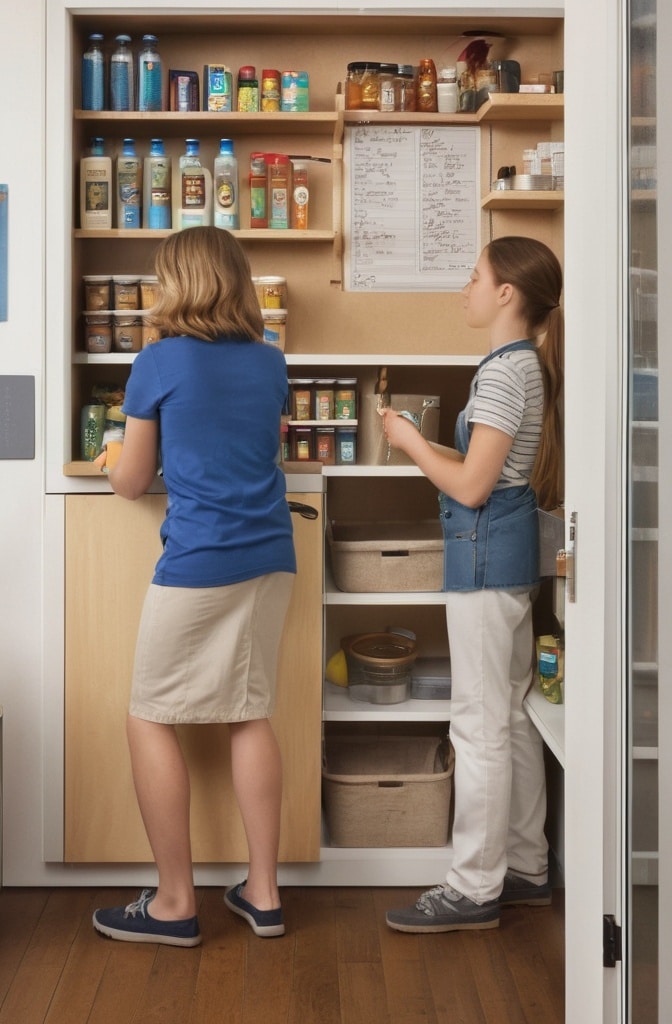
Even the most beautiful organization system fails without sustainable maintenance routines.
Weekly Reset Routines that Take Under 15 Minutes
Brief, regular maintenance prevents major pantry chaos:
- 10-minute weekly shelf check before grocery shopping
- Quick container refills from backup storage
- Label updates for changed contents
- Wiping of high-touch surfaces
- Repositioning of displaced items
“The secret to maintaining any organization system is regular small efforts rather than occasional overhauls,” advises time management expert Laura Vanderkam. Schedule these quick resets at consistent times, such as before making your grocery list, to establish the habit.
Seasonal Pantry Refresh Schedule
More thorough pantry maintenance aligns well with seasonal changes:
- Spring: Deep cleaning and container washing
- Summer: Reorganization for seasonal cooking patterns
- Fall: Stocking up on school lunch or holiday essentials
- Winter: Inventory assessment and storage evaluation
These quarterly sessions provide opportunities to assess what’s working, adjust systems that aren’t, and ensure food safety through rotation and expiration date checks.
Family Involvement Strategies
Sustainable pantry organization requires participation from all household members:
- Clear visual systems that all ages can understand
- Age-appropriate responsibilities for maintenance
- Regular family updates when systems change
- Feedback mechanisms for what’s working/not working
- Rewards or incentives for maintaining organization
“The most effective family systems account for everyone’s capabilities and preferences,” notes family organization expert Jessica Litman. “A system that only works when one person maintains it isn’t sustainable long-term.”
Adjusting Systems as Household Needs Change
Pantry organization should evolve with your household:
- Children growing and accessing different items
- Dietary changes requiring new categories
- Life stage transitions affecting cooking patterns
- New hobbies or interests changing food storage needs
- Seasonal activities influencing grocery habits
Schedule periodic evaluations of your system’s effectiveness, perhaps alongside seasonal refreshes, to ensure your organization continues to serve your current needs rather than outdated patterns.
Preventing Common Organization Breakdown Points
Certain issues frequently derail pantry organization. Preventive measures include:
- Creating designated landing zones for new groceries
- Establishing clear processes for emptying and refilling containers
- Using inventory systems for items stored out of sight
- Planning for irregularly shaped packages
- Accommodating household members with different organization styles
“Most organization breakdowns happen at transition points,” observes systems expert Alison Lush. “Focus your most robust systems on the moments when items enter, move within, or leave your pantry.”
Real-Life Pantry Transformations
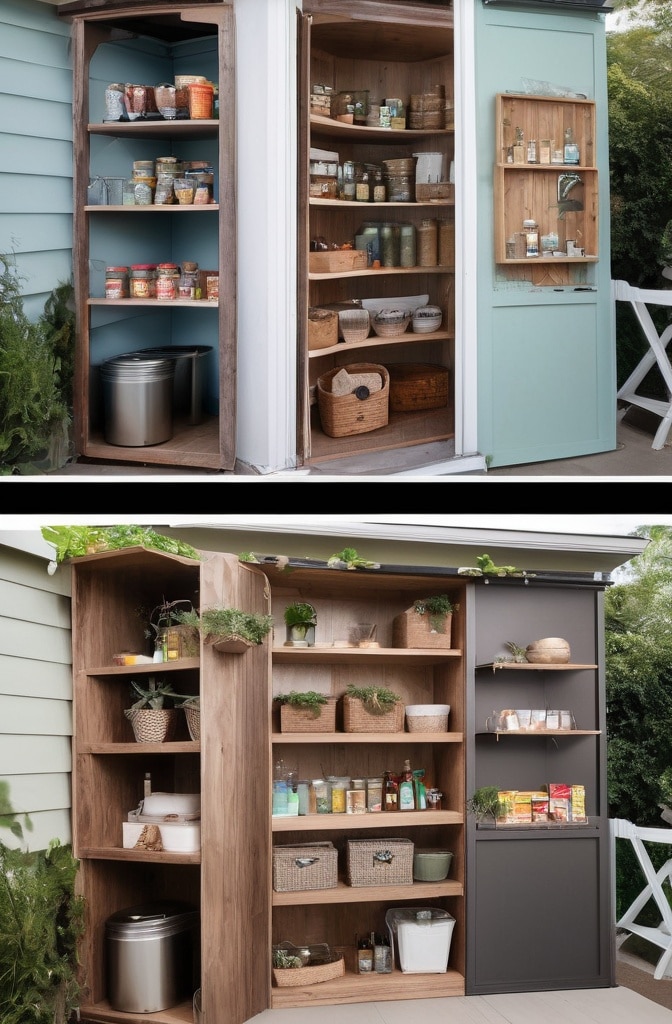
Abstract organization principles become concrete through real-world examples.
Small Apartment Pantry Makeover Case Study
Urban designer Maya Chen transformed a 24″ wide cabinet into a highly functional pantry for her family of three:
Before challenges:
- Limited visibility caused food waste
- Inefficient use of vertical space
- Difficulty accessing items at the back
- No system for tracking inventory
Solutions implemented:
- Door-mounted spice rack
- Pull-out drawers for canned goods
- Stackable container system for baking supplies
- Label system with purchase dates
- Digital inventory linked to grocery delivery service
Results:
- 40% more storage capacity
- Reduced food waste
- Streamlined grocery ordering
- Easier meal preparation
“The key was maximizing every vertical inch and creating systems that worked with our urban lifestyle rather than against it,” Maya explains.
Family of Five’s Functional System Walkthrough
The Johnson family transformed their walk-in pantry to better serve their busy household:
Before challenges:
- Children couldn’t find or reach appropriate snacks
- Sports schedule created rushed meal preparation
- Special dietary needs required separate storage
- Bulk shopping led to forgotten inventory
Solutions implemented:
- Color-coded zones for different family members
- Kid-height snack station with healthy options
- Meal kit bins prepared weekly for quick dinners
- Allergy-safe zone with separate containers
- Inventory whiteboard for bulk storage areas
Results:
- Children gained independence in food selection
- Weeknight meal prep time reduced by 15 minutes
- Zero allergy cross-contamination incidents
- Grocery budget reduced by 20% through better inventory management
“Our pantry now functions as command central for our family’s food needs,” shares parent Jordan Johnson. “The systems have grown with our children and adapted to our changing schedules.”
Rental-Friendly Organization Solutions
Tenant Taylor Rivera created a functional pantry without permanent modifications:
Before challenges:
- Fixed shelving at inefficient heights
- No permission for drilling or permanent changes
- Awkward corner cabinet with poor accessibility
- Limited budget for organization solutions
Solutions implemented:
- Freestanding shelf risers to create additional levels
- Tension rods to divide vertical spaces
- Removable adhesive hooks for tool storage
- Baskets with handles for “drawer” functionality
- Repurposed containers with unified labeling system
Results:
- Tripled usable storage capacity
- Created zones for different meal categories
- Improved visibility of all items
- Total investment under $150
- Completely removable when lease ends
“Rental pantries require creativity rather than construction,” Taylor notes. “The constraint of not making permanent changes actually led to more flexible solutions.”
Budget Transformation Examples with Cost Breakdown
By prioritizing key organizing elements and supplementing with repurposed household items, they achieved significant improvement without exceeding their budget constraints.
“We focused our spending on the items that would make the biggest functional difference,” explains homeowner Jamie Williams. “The aesthetic improvements followed naturally from the improved organization.”
Conclusion
A well-organized pantry represents more than just tidy shelves—it’s a system that supports your household’s unique relationship with food. From meal preparation efficiency to reduced food waste and grocery budgets, the benefits extend far beyond the satisfaction of Instagram-worthy shelving.
